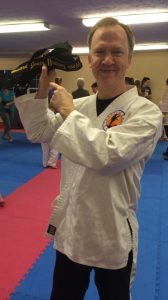Karate Form
 I’ve realized a curious fact about the way I learn katas taught at my karate school.
I’ve realized a curious fact about the way I learn katas taught at my karate school.
If you’re not in the know, katas, or forms, are the somewhat dance-like patterns that martial arts students perform to master various techniques. The longer you’ve been practicing, the more katas you learn. Continued rehearsal of the katas improves not just your ability to perform them, but provides physical benefits. Once you stretch every day and run some katas, you’ve definitely performed a workout. But the benefits are greater than this. After a while you notice the stances and practice of balance intercalate themselves into your daily habits. Your reflexes improve profoundly.
For instance if I’m surprised — say a kid’s running past me at a pool — I do a quick sidestep without thinking about it. After learning an upper-level kata with multiple crane stances, which were extremely challenging at first, my own balance improved overall. If I’m bumped, I immediately ground myself into a more sturdy stance. And don’t be the person who grabs me from behind in jest, for you may find me spinning to face you with hands ready to strike. I alarmed a friend (and myself, a little) when she was just giving me a surprise shoulder squeeze.
An additional benefit is that once you learn the kata, you have to clear your mind to perform it. You can’t be thinking about food, or a deadline, or an algebra problem. You’re making the movements without thinking about them with a sort of “upper level” of your brain. You have to have absorbed the form at a deeper level so that you have “muscle memory” of what you need to do, because you don’t have time to stop and think. You basically enter into what I believe is kind of a meditative state. Your mind is clear of everything but running the form.
Maybe I’m crazy, but I think that’s wonderful for the ‘ol brain, and just one reason karate is good for you both physically and mentally.
Here’s the curious thing. Typically we learn our katas facing the east wall of the school. At home I can perform that kata facing any old direction I want. But if I’m at the school, I can only run the kata another direction once I have truly mastered it. I realized if I was at home running the form, in my head I was always facing that west wall, and it’s much easier running the form while facing that wall when you’re not confronted with it at at a different spot in the kata. It’s pattern memory, and one of the ways my brain makes that pattern work is by having me imagine, at some level, that I’m always in the spot where I first learned the kata.
Other students, my wife among them (she’s now studying for her second degree black belt) don’t seem to have this problem! Once they learn the kata they’re able to run it any old direction they want.
0 Comments